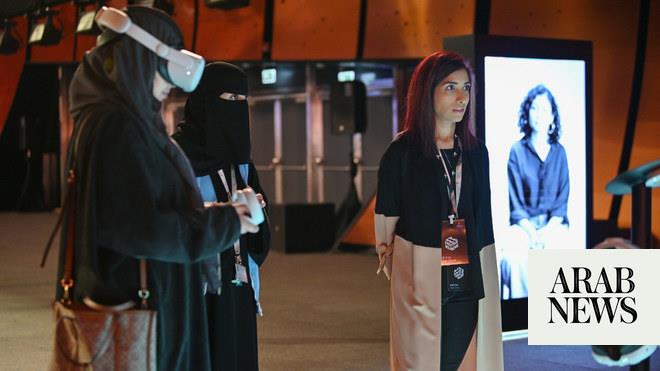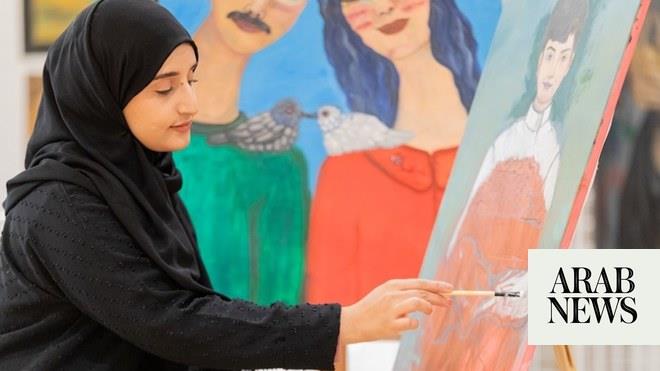
DHAHRAN: The exhibition “Amakin,” which opened on June 30, is on display at the King Abdulaziz Center for World Culture, or Ithra.
Originating in Jeddah, the exhibition features the original and archived creations of 28 artists from different generations and, according to curator Venetia Porter, tells the stories behind places that are meaningful to the artists, “whether it is a physical place or a place in the imagination.” Indeed, the name, which in Arabic means “places,” is an invitation for artists to explore sites of emotional significance to them.
One featured creative is pioneer artist and author Abdulrahman Al-Soliman, whose home in Dammam — a room filled with sofas, stacks of books on large shelves and paintings on the walls — was a meeting point for artists for over a decade.
Born in Al-Hassa in 1954, his contribution to the Saudi art world is immeasurable. Starting in 2005, his home became a refuge where artists gathered twice a month to discuss the art scene and collaborate. In 1974, he began teaching art and has since worked continuously to elevate art in the country and the region at large. His mixed media works, which he calls his “diaries,” are displayed at “Amakin.”
Manal Al-Dowayan’s project, titled ‘Just Paper,’ explores the juxtaposition between fragility and hardness. (Supplied)
Manal Al-Dowayan, an artist with two decades of experience in the professional Saudi art scene, found herself searching for a “makan,” or place, while the COVID-19 pandemic raged beyond her locked door.
The year 2020 stripped her of certainty, joy and connection with other people, the artist explained, and she longed for a sense of serenity in the chaotic world. HIGH LIGHT
Originating in Jeddah, the exhibition features the original and archived creations of 28 artists from different generations and, according to curator Venetia Porter, tells the stories behind places that are meaningful to the artists, ‘whether it is a physical place or a place in the imagination.’
As messages of doom and gloom lingered in the news headlines, she found herself trying to make sense of what she labeled as a “dense political and psychological space.”
Once the world started opening up again and she was able to venture out, she tried to heal from what she referred to as a “traumatic year” by taking refuge in art. She chose a book from her father’s library and used it as inspiration.
Bader Awwad AlBalawi‘s photography at ‘Amakin’ exhibition
The result was a piece composed of 222 scattered porcelain scrolls with printed pages from the book she borrowed from her father.
“I am an artist from the Eastern Province. I was born in Dhahran. I’ve been a part of this exhibition from the very beginning. I am very pleased and honored that, for the first time, it is now opening in my hometown, Dhahran, and in our home as artists, Ithra,” Al-Dowayan told Arab News.
Her project, entitled “Just Paper,” explores the juxtaposition between fragility and hardness.
“My artwork addresses the moment we were coming out of the pandemic. I decided to create this artwork as a way of healing from the fear and politicized spaces of the pandemic era. It is called ‘Just Paper,’ and it plays with medium as, instead of using paper, I used porcelain, which is very delicate and can be crushed easily,” she told Arab News.
In her creation for “Amakin,” Al-Dowayan used pages from the book by writer and lexicographer Abu Mansour Al-Tha’albi entitled, “The Jurisprudence of the Arabic Language.”
Talib Almarri‘s photography at ‘Amakin’. (Supplied)
The text, in Arabic, “groups vocabulary by semantic field and discusses points of Arabic grammar.”
Entire pages of the text were silk-screened onto porcelain and then placed into a hot kiln. After they emerged from the fire, they were fastened with jute string and stacked onto a white table. Only glimpses of the words can be visible, but the lines glisten in the light.
Another Shargiyya artist is Talib Al-Marri. Born and based in Alkhobar, he is a self-taught photographer who ventured out at 4:00 a.m. to the Yellow Lake in Al-Hassa in order to photograph birds in their natural habitat.
The lake is recognized as a UNESCO World Heritage site for its great environmental diversity, attracting birds such as the white heron, which Al-Marri enjoys photographing.
His images are in black and white, as he feels it gives his subjects the power they deserve.
Another participating Shargiyya photographer captured the transformation of Alkhobar in a different way. Bader Awwad Al-Balawi uses photography as a medium to make “sense of the place, its buildings, the people who lived in them, the well-known landmarks.”
For “Amakin,” Al-Balawi took snapshots of local residents in North Alkhobar, documenting the expats who have made the city their home. His photographs of buildings in the area also now serve as a historic archive of how the city used to be and its resilience — before, during and after the pandemic.












